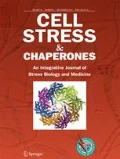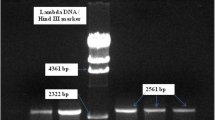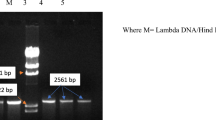Abstract
The present study was undertaken to investigate genetic variability in a fragment comprising 5′UTR along with partial coding sequence of Hsp70 gene and its association with thermotolerance traits in Murrah buffalo at ICAR-Research Complex for Eastern Region, Patna (India). The allelic variants were identified from genomic DNA samples using SSCP technique. The PCR products were sequenced and analyzed. Data on different thermotolerance traits recorded in three seasons were analyzed by least squares ANOVA taking the SSCP genotypes as fixed effect. Two allelic variants (A and B), each of 503-bp in size, were documented with frequency of 0.59 and 0.41, respectively, and three genotypes (AA, AB and BB) with corresponding frequency of 0.30, 0.58 and 0.12. The allelic variants were due to single nucleotide substitution at 55th base position leading to a change of threonine (A) to methionine (B) in amino acid sequence. Both the allelic variants had 99.8% similarity in nucleotide sequence. In phylogenetic tree, allele A was in a cluster while allele B and Gangatiri cattle sequence formed a different cluster. The SSCP genotypes had significant effect on different thermotolerance traits in summer with thermo-humidity index of ≥ 84. Buffaloes with AA genotype had the highest (P ˂ 0.05) summer evening rectal temperature, respiration rate and pulse rate, inferring that the buffaloes carrying AA genotype had more stress in summer than those with AB and BB genotype. These SSCP genotypes might have differential role in heat shock protein response to induce thermotolerance of Murrah buffaloes in Gangetic plains.





Similar content being viewed by others
References
Basirico L, Morera P, Primi V, Lacetera N, Nardone A, Bernabucci U (2011) Cellular thermotolerance is associated with heat shock protein 70.1 genetic polymorphisms in Holstein lactating cows. Cell Stress Chaperones 16:441–448
Bassam BJ, Caetano-Anolles G, Gresshoff PM (1991) Fast and sensitive silver staining of DNA in polyacrylamide gels. Biochemistry 196:80–83
Beckham JT, Mackanos MA, Crooke C, Takahashi T, O’connell-Rodwell C, Contag CH, Jansen ED (2004) Assessment of cellular response to thermal laser injury through bioluminescence imaging of heat shock protein 70. Photochem Photobiol 79:76–85
Bhat S, Kumar P, Neeraj K, Deshmukh B, Dige MS, Bhushan B, Chauhan A, Kumar A, Singh G (2016) Effect of heat shock protein 70 polymorphism on thermotolerance in Tharparkar cattle. Vet World 9(2):113–117
Boon-Niermeijer EK, Souren JE, van Wijk R (1987) Thermotolerance induced by 2,4-dinitrophenol. Int J Hyperth 3:133–141
Crozier LG, Hendry AP, Lawson PW, Quinn TP, Mantua NJ, Battin J, Shaw RG, Huey RB (2008) Potential responses to climate change in organisms with complex life histories: evolution and plasticity in Pacific salmon. Evol Appl 1(2):252–270
Falconer DS, Mackay TFC (1996) Introduction to quantitative genetics, 4th edn. Addison Wesiey Longman, Harlow, Essex
Gabai VL, Meriin AB, Mosser DD, Caron AW, Rits S, Shifrin VI, Sherman MY (1997) Hsp70 prevents activation of stress kinases. A novel pathway of cellular thermotolerance. J Biol Chem 272:18033–18037
Hansen PJ (2004) Physiological and cellular adaptations of zebu cattle to thermal stress. Anim Reprod Sci 82-83:349–360
Harley B, Wright C, Hall R, Dery K (2006) Management reactions to technological change: the example of enterprise resource planning. J Appl Behav Sci 42(1):58–75
Kumar B (2019) Genetic profiling of heat shock protein 70 gene in Murrah buffalo. PhD Thesis, West Bengal University of Animal and Fishery Sciences, 68 Kshudiram Bose Sarani, Kolkata-700037, West Bengal, India
Kumar R, Gupta ID, Verma A, Verma N, Magotra A, Vineeth MR (2015) Molecular characterization and polymorphism detection in HSPB6 gene in Sahiwal cattle. Indian J Anim Res 49(5):595–598
Kumar B, Sahoo AK, Dayal S, Das AK, Taraphder S, Batabyal S, Ray PK, Kumari R (2019) Genetic profiling of Hsp70 gene in Muarrah buffalo (Bubalus bubalis) under sub-tropical climate of India. Cell Stress Chaperones 24(6):1187–1195
Lamb, Okimoto M, Brown RM, Rosenkranes C Jr (2007) Associations between cattle breed and heat shock protein 70 gene. AAES Res Series 545:205–206
Leppa S, Sistonen L (1997) Heat shock response- pathophysiological implications. Ann Med 29(1):73–78
Marai IFM, Habeeb AAM (2010) Buffalo’s biological functions as affected by heat stress-a review. Livest Sci 127:89–109
Mcmanus C, Paluda GR, Louvandini H, Gugel R, Sasaki LCB, Paiva SR (2009) Heat tolerance in Brazilian sheep: physiological and blood parameters. Trop Anim Health Prod 41:95–101
National Research Council (1971) A guide to environmental research on animals. Nat Acad Sci Washington, DC
Oner Y, Keskin A, Ustuner H, Soysal D, Karakaş V (2017) Genetic diversity of the 3′ and 5′ untranslated regions of the HSP70.1 gene between native Turkish and Holstein Friesian cattle breeds. S Afr J Anim Sci 47(4):424–439
Padilla L, Matsui T, Kamiya Y, Kamiya M, Tanaka M (2006) Heat stress decreases plasma vitamin C concentration in lactating cows. Livest Sci 101:300–304
Pawar HN, Kumar GVPPSR, Narang R, Agrawal RK (2014) Heat and cold stress enhances the expression of heat shock protein70, heat shock transcription factor 1 and cytokines (IL-12, TNF- and GMCSF) in buffaloes. Int J Cur Microbiol Appl Sci 3(21):307–317
Rao M, Yadav M, Ramesh K, Uniyal S, Rastogi SK, Sejian V, Hyder I (2015) HSP70 as a marker of heat and humidity stress in Tarai buffalo. Trop Anim Health Prod 47(1):111–116
Ross OA, Curran MD, Crum KA, Rea IM, Barnett YA, Middleton D (2003) Increased frequency of the 2437T allele of the heat shock protein 70-Hom gene in an aged Irish population. Exp Gerontol 38:561–565
SAS Institute Inc (2008) SAS/STAT® 9.2 User’s Guide. Cary, NC: SAS Institute Inc.
Shabtay A, Arad Z (2005) Ectothermy and endothermy: evolutionary perspectives of thermoprotection by HSPs. J Exp Biol 208:2773–2781
Singh AK, Upadhyay RC, Malakar D, Kumar S, Singh SV (2014) Effect of thermal stress on Hsp70 expression in dermal fibroblast of zebu (Tharparkar) and crossbred (Karan Fries) cattle. J Thermal Biol 43:46–53
Smith BJ, Yaffe MP (1991) Uncoupling thermotolerance from the induction of heat shock proteins. Proc Natl Acad Sci 88:11091–11094
Sodhi M, Mukesh M, Kishore A, Mishra BP, Kataria RS, Joshi BK (2013) Novel polymorphisms in UTR and coding region of inducible heat shock protein 70.1 gene in tropically adapted Indian zebu cattle (Bos indicus) and riverine buffalo (Bubalus bubalis). Gene 527(2):606–615
Thiruvenkadan AK, Rajendran R, Muralidharan J (2013) Buffalo genetic resources of India and their conservation. Buffalo Bull 32:227–235
Wimmers K, Ponsuksili S, Hardge T, Valle-Zarate A, Mathur PK, Horst P (2000) Genetic distinctness of African, Asian and South American local chickens. Anim Genet 31:159–165
Xiao C, Chen S, Li J, Hai T, Lu Q, Sun E, Wang R, Tanguay RM, Wu T (2002) Association of Hsp70 and genotoxic damage in lymphocytes of workers exposed to coke-oven emission. Cell Stress Chaperones 7(4):396–402
Acknowledgements
The authors are thankful to the Director, ICAR-Research Complex for Eastern Region, Patna, Bihar (India), for giving the necessary permission towards the first author’s PhD dissertation research work to be carried out at its Division of Livestock and Fishery Management and duly acknowledge the kind cooperation sincerely extended by the Scientists and staff of this Division.
Author information
Authors and Affiliations
Corresponding author
Ethics declarations
Conflict of interest
The authors declare that they have no conflict of interest.
Additional information
Publisher’s note
Springer Nature remains neutral with regard to jurisdictional claims in published maps and institutional affiliations.
Rights and permissions
About this article
Cite this article
Kumar, B., Sahoo, A.K., Dayal, S. et al. Investigating genetic variability in Hsp70 gene-5′-fragment and its association with thermotolerance in Murrah buffalo (Bubalus bubalis) under sub-tropical climate of India. Cell Stress and Chaperones 25, 317–326 (2020). https://doi.org/10.1007/s12192-020-01075-3
Received:
Revised:
Accepted:
Published:
Issue Date:
DOI: https://doi.org/10.1007/s12192-020-01075-3




